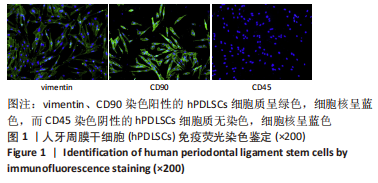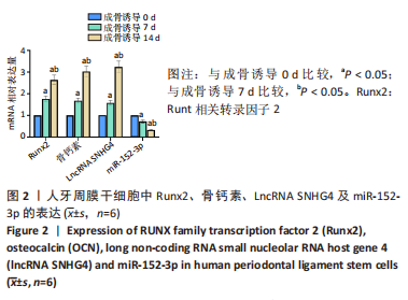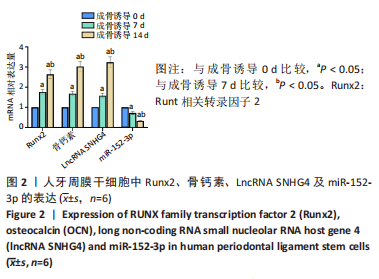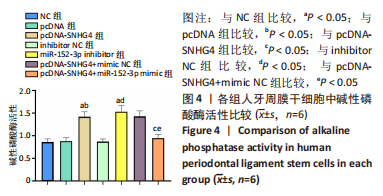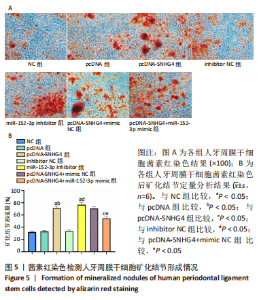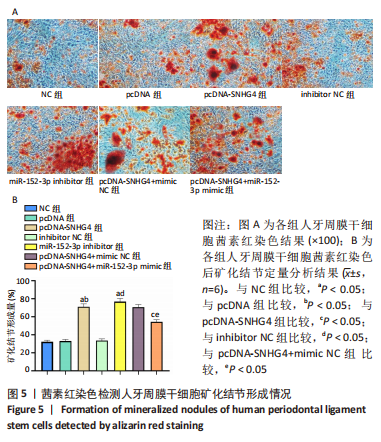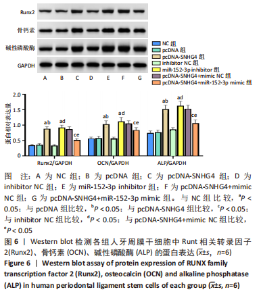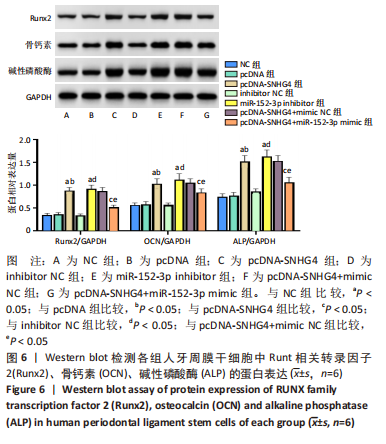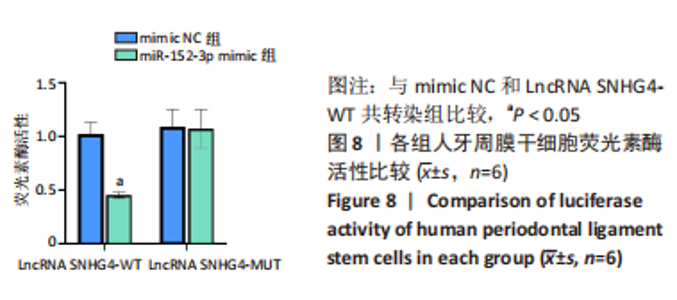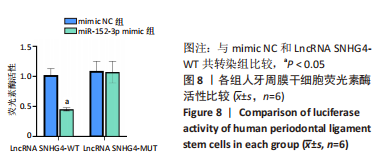Chinese Journal of Tissue Engineering Research ›› 2024, Vol. 28 ›› Issue (1): 38-43.doi: 10.12307/2023.791
Previous Articles Next Articles
LncRNA SNHG4 regulates miR-152-3p during osteoblastic differentiation of periodontal ligament stem cells
Zhou Minghua1, Hu Xiaoyu2
- 1Department of Stomatology, Henan University of Economics and Law Hospital, Zhengzhou 450046, Henan Province, China; 2Stomatological Hospital, Pingdingshan College, Pingdingshan 467000, Henan Province, China
-
Received:2022-12-16Accepted:2023-01-18Online:2024-01-08Published:2023-06-28 -
Contact:Zhou Minghua, Attending physician, Department of Stomatology, Henan University of Economics and Law Hospital, Zhengzhou 450046, Henan Province, China -
About author:Zhou Minghua, Attending physician, Department of Stomatology, Henan University of Economics and Law Hospital, Zhengzhou 450046, Henan Province, China
CLC Number:
Cite this article
Zhou Minghua, Hu Xiaoyu. LncRNA SNHG4 regulates miR-152-3p during osteoblastic differentiation of periodontal ligament stem cells[J]. Chinese Journal of Tissue Engineering Research, 2024, 28(1): 38-43.
share this article
Add to citation manager EndNote|Reference Manager|ProCite|BibTeX|RefWorks

2.3 各转染组hPDLSCs中LncRNA SNHG4、miR-152-3p表达及hPDLSCs增殖能力的比较 与NC组、pcDNA组比较,pcDNA-SNHG4组LncRNA SNHG4表达、A450值升高,miR-152-3p表达降低(P < 0.05);与NC组、inhibitor NC组比较,miR-152-3p inhibitor组LncRNA SNHG4表达变化无显著性意义(P > 0.05),miR-152-3p表达降低,A450值升高(P < 0.05);与pcDNA-SNHG4组、pcDNA-SNHG4+mimic NC组比较,pcDNA-SNHG4+miR-152-3p mimic 组LncRNA SNHG4表达变化差异无显著性意义(P > 0.05),miR-152-3p表达升高,A450值降低(P < 0.05),见图3。"
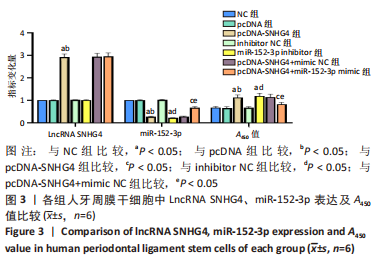
| [1] WANG S, DUAN Y. LncRNA OIP5-AS1 inhibits the lipopolysaccharide-induced inflammatory response and promotes osteogenic differentiation of human periodontal ligament cells by sponging miR-92a-3p. Bioengineered. 2022;13(5):12055-12066. [2] ZHAO Y, QUAN Y, LEI T, et al. The role of inflammasome NLPR3 in the development and therapy of periodontitis. Int J Med Sci. 2022;19(10): 1603-1614. [3] USKOKOVIC V, PEJCIC A, KOLIQI R, et al. Polymeric nanotechnologies for the treatment of periodontitis: A chronological review. Int J Pharm. 2022;625(1):122065-122086. [4] LI C, QI Y, ZHOU Q, et al. Betulinic acid promotes the osteogenic differentiation of human periodontal ligament stem cells by upregulating EGR1. Acta Biochim Biophys Sin (Shanghai). 2021;53(10): 1266-1276. [5] HUA L, ZHANG X. MALAT1 regulates osteogenic differentiation of human periodontal ligament stem cells through mediating miR-155-5p/ETS1 axis. Tissue Cell. 2021;73(1):101619-101648. [6] ADACHI O, SUGII H, ITOYAMA T, et al. Decorin promotes osteoblastic differentiation of Human periodontal ligament stem cells. Molecules. 2022;27(23):8224-8239. [7] HOU J, XU J, LIU Y, et al. Sodium butyrate inhibits osteogenesis in human periodontal ligament stem cells by suppressing smad1 expression. BMC Oral Health. 2022;22(1):301-310. [8] LI SX, YAN W, LIU JP, et al. Long noncoding RNA SNHG4 remits lipopolysaccharide-engendered inflammatory lung damage by inhibiting METTL3 - Mediated m6A level of STAT2 mRNA. Mol Immunol. 2021;139(1):10-22. [9] WU D, MA L. Downregulating microRNA-152-3p promotes the viability and osteogenic differentiation of periodontal ligament stem cells via targeting integrin alpha 5. Arch Oral Biol. 2020;120(1):104930-104939. [10] SHI F, HE R, ZHU J, et al. miR-589-3p promoted osteogenic differentiation of periodontal ligament stem cells through targeting ATF1. J Orthop Surg Res. 2022;17(1):221-232. [11] LI J, WANG Z, HUANG X, et al. Dynamic proteomic profiling of human periodontal ligament stem cells during osteogenic differentiation. Stem Cell Res Ther. 2021;12(1):98-113. [12] QUEIROZ A, ALBUQUERQUE-SOUZA E, GASPARONI LM, et al. Therapeutic potential of periodontal ligament stem cells. World J Stem Cells. 2021;13(6):605-618. [13] 董霞,王训霞,杨芳.miR-34a对人牙周膜干细胞成骨分化的促进作用及其机制[J].吉林大学学报(医学版),2021,47(6):1362-1370. [14] 刘娟,陈斌,闫福华.富血小板血浆和浓缩生长因子对人牙周膜细胞增殖和成骨分化影响的研究[J].国际口腔医学杂志,2021,48(5): 520-527. [15] 邹小炎,陈霞,冀道之,等.在牙周膜成纤维细胞中过表达 Lnc RNA-KAT7可抑制脂多糖诱导的炎症因子 IL-17 的表达[J/OL].实用口腔医学杂志.https://kns.cnki.net/kcms/detail/61.1062.R. 20221115.0850.002.html [16] LI J, JIN F, CAI M, et al. LncRNA nron inhibits bone resorption in periodontitis. J Dent Res. 2022;101(2):187-195. [17] QIN Q, YANG H, ZHANG C, et al. lncRNA HHIP-AS1 promotes the osteogenic differentiation potential and inhibits the migration ability of periodontal ligament stem cells. Stem Cells Int. 2021;2021:5595580. [18] 庄晓鹏,刘友东,郑宾宾,等.LncRNA SNHG4在结直肠癌中的表达及对细胞奥沙利铂耐药性的影响[J].现代生物医学进展,2022, 22(2):207-212. [19] 韩涵,喻鑫,周波,等.长非编码RNA-SNHG4促进胃癌细胞增殖生长并介导对化疗药物顺铂耐药性的研究[J].安徽医科大学学报, 2021,56(7):1047-1051. [20] KAWANE T, QIN X, JIANG Q, et al. Runx2 is required for the proliferation of osteoblast progenitors and induces proliferation by regulating Fgfr2and Fgfr3. Sci Rep. 2018;8(1):13551-13567. [21] ZENG L, HE H, SUN M, et al. Runx2 and Nell-1 in dental follicle progenitor cells regulate bone remodeling and tooth eruption. Stem Cell Res Ther. 2022;13(1):486-498. [22] KUSUYAMA J, AMIR MS, ALBERTSON BG, et al. JNK inactivation suppresses osteogenic differentiation,but robustly induces osteopontin expression in osteoblasts through the induction of inhibitor of DNAbinding 4 (Id4). FASEB J. 2019;33(6):7331-7347. [23] 罗小玲,张丽,杨茂桦,等.柚皮素干预人牙周膜干细胞的成骨分化能力[J].中国组织工程研究,2022,26(7):1051-1056. [24] WAN HY, SHIN RLY, CHEN JCH, et al. Dextran sulfate-amplified extracellular matrix deposition promotes osteogenic differentiation of mesenchymal stem cells. Acta Biomater. 2022;140(1):163-177. [25] YU Z, GAUTHIER P, TRAN QT, et al. Differential properties of human ALP+periodontal ligament stem cells vs their ALP-counterparts. J Stem Cell Res Ther. 2015;5(7):292-302. [26] ZHANG X, ZHANG Y, YANG L, et al. IRF4 suppresses osteogenic differentiation of BM-MSCs by transcriptionally activating miR-636/DOCK9 axis. Clinics (Sao Paulo). 2022;77(1):100019-100024. [27] WANG Q, LIN H, RAN J, et al. miR-200a-3p represses osteogenesis of human periodontal ligament stem cells by targeting ZEB2 and activating the NF-κB pathway. Acta Odontol Scand. 2022;80(2):140-149. [28] ZHOU H, CHEN D, XIE G, et al. LncRNA-mediated ceRNA network was identified as a crucial determinant of differential effects in periodontitis and periimplantitis by high-throughput sequencing. Clin Implant Dent Relat Res. 2020;22(3):424-450. [29] SAYAD A, MIRZAJANI S, GHOLAMI L, et al. Emerging role of long non-coding RNAs in the pathogenesis of periodontitis. Biomed Pharmacother. 2020;129(1):110362-110367. [30] 李双庆,崔书伟,武瑞臣.miR-152-3p通过调控DUSP1对激素性股骨头坏死BMSCs成骨分化的作用研究[J].重庆医学,2022,51(14): 2341-2345. |
| [1] | Wei Yurou, Tian Jiaqing, He Xianshun, Zhan Zhiwei, Wei Tengfei, Lin Tianye, He Wei, Wei Qiushi. Effect of lentiviral silencing of Piezo1 on osteogenic differentiation and TAZ expression in human bone marrow mesenchymal stem cells [J]. Chinese Journal of Tissue Engineering Research, 2024, 28(1): 12-19. |
| [2] | Wang Xianfeng, Wang Kun, Sun Han, Sun Xiaoliang, Yan Litao. Mechanism underlying exosomal lncRNA H19 derived from umbilical cord mesenchymal stem cells promotes cartilage injury repair [J]. Chinese Journal of Tissue Engineering Research, 2024, 28(1): 20-25. |
| [3] | Zhang Yuanshu, He Xu, Xue Yuan, Jin Yesheng, Wang Kai, Shi Qin, Rui Yongjun. Irisin alleviates palmitic acid-induced osteogenic inhibition in bone marrow mesenchymal stem cells [J]. Chinese Journal of Tissue Engineering Research, 2024, 28(1): 26-31. |
| [4] | Fan Yongjing, Wang Shu, Jin Wulong. Characteristics, advantages and application of osteogenic differentiation of jaw bone marrow mesenchymal stem cells [J]. Chinese Journal of Tissue Engineering Research, 2024, 28(1): 100-106. |
| [5] | Yang Zhishan, Tang Zhenglong. YAP/TAZ, a core factor of the Hippo signaling pathway, is involved in bone formation [J]. Chinese Journal of Tissue Engineering Research, 2023, 27(8): 1264-1271. |
| [6] | Liu Wentao, Feng Xingchao, Yang Yi, Bai Shengbin. Effect of M2 macrophage-derived exosomes on osteogenic differentiation of bone marrow mesenchymal stem cells [J]. Chinese Journal of Tissue Engineering Research, 2023, 27(6): 840-845. |
| [7] | Long Yanming, Xie Mengsheng, Huang Jiajie, Xue Wenli, Rong Hui, Li Xiaojie. Casein kinase 2-interaction protein-1 regulates the osteogenic ability of bone marrow mesenchymal stem cells in osteoporosis rats [J]. Chinese Journal of Tissue Engineering Research, 2023, 27(6): 878-882. |
| [8] | Li Xinyue, Li Xiheng, Mao Tianjiao, Tang Liang, Li Jiang. Three-dimensional culture affects morphology, activity and osteogenic differentiation of human periodontal ligament stem cells [J]. Chinese Journal of Tissue Engineering Research, 2023, 27(6): 846-852. |
| [9] | Yuan Wei, Liu Jingdong, Xu Guanghui, Kang Jian, Li Fuping, Wang Yingjie, Zhi Zhongzheng, Li Guanwu. Osteogenic differentiation of human perivascular stem cells and its regulation based on Wnt/beta-catenin signaling pathway [J]. Chinese Journal of Tissue Engineering Research, 2023, 27(6): 866-871. |
| [10] | Hu Xinming, Qiao Yanhua, Wang Xiaofan, Li Linyu, Zhao Bing. Mechanism of long non-coding RNA plasmacytoma variant translocation 1 involved in pelvic organ prolapse [J]. Chinese Journal of Tissue Engineering Research, 2023, 27(5): 669-675. |
| [11] | Li Zhichao, Tan Guoqing, Su Hui, Xu Zhanwang, Xue Haipeng. Regulatory role of non-coding RNAs as potential therapeutic targets in spinal cord injury [J]. Chinese Journal of Tissue Engineering Research, 2023, 27(5): 758-764. |
| [12] | Shao Zichen, Li Huanan, Gu Bing, Zhang Xiaoyun, Sun Weikang, Liu Yongqian, Gan Bin. MicroRNA, long non-coding RNA and circular RNA mediate the mechanism of decreasing uric acid, anti-inflammation and regulating bone metabolism in gout [J]. Chinese Journal of Tissue Engineering Research, 2023, 27(5): 765-771. |
| [13] | Qin Yixiong, Yuan Zijian, Xie Shanzhou, Zhu Yingwen, Chen Minghui, Han Biao, Guo Yong. Effect of tea polyphenols on proliferation and differentiation of osteoblasts stimulated by lipopolysaccharide [J]. Chinese Journal of Tissue Engineering Research, 2023, 27(35): 5665-5669. |
| [14] | Huang Qian, Hao Liying, He Longlong, Du Liangzhi. Graphene oxide-chitosan composite coating affects the biological behavior of osteoblasts [J]. Chinese Journal of Tissue Engineering Research, 2023, 27(34): 5430-5435. |
| [15] | You Yan, Chen Jiawen, Lin Binbin, Wu Jingyi, Liu Peng, Wu Buling, Sun Tianyu. Mechanism and application of glycosaminoglycan in bone tissue engineering [J]. Chinese Journal of Tissue Engineering Research, 2023, 27(34): 5538-5545. |
| Viewed | ||||||
|
Full text |
|
|||||
|
Abstract |
|
|||||

